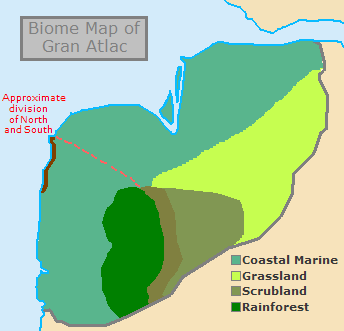Gran Atlac
The People's Republic of Gran Atlac is a small, socially progressive nation in the region of Q102. Its hard-nosed population of 14 million have some civil rights, but not too many, enjoy the freedom to spend their money however they like, to a point, and take part in free and open elections, although not too often. The small government is effectively ruled by the Department of Law & Order, with areas such as Social Welfare and Religion & Spirituality receiving almost no funds by comparison. Education and welfare spending are on the rise, military spending recently hit a new high. Citizens pay a flat income tax of 8%. A small but healthy private sector is led by the Information Technology industry, followed by Basket Weaving and Automobile Manufacturing. Voting is voluntary, Gran Atlac's children are widely acknowledged as the most foul-mouthed in the region, euthanasia is legal, and the mining industry is making inroads into environmentally sensitive areas. Crime is a problem, though recent measures by the government hope to reduce it. All major public areas are watched by police surveillance cameras, and gambling is outlawed.. Gran Atlac's national animal is the quiri-quiri, and its currency is the Atlac Peso. The UN currently regards Gran Atlac as an Inoffensive Centrist Democracy.
Regions of Gran AtlacThere are five main regions in Gran Atlac: the Northern Coast, the Southern Coast, the rainforest, the Inland Plains and the Southern Scrublands. The Northern Coast The Northern Coast is the most populated region of Gran Atlac, having two-thirds of the nation's population, including Gran Atlac, the capital city. The region is dominated by a megalopolis of coastal cities. West to East they are: Cappa, Cien Milla, Port Nix, Burdo, Gran Atlac, and Punto Norte. To the north of Punto Norte is the resort town of Descanso, on the edge of the river. Away from the cities, to the southeast, there is much agricultural activity, including the many vinyards of Sundyr. Port Nix is both the commercial shipping center for the entire country as well as the main shipyard. The Southern Coast The Southern Coast is isolated, both geographically and culturally, from the Northern Coast. There is one main city, Ixi, which has the main port for the area. Ixi is home to the vast commercial fishing fleet of the nation. The suburbs of Northport and Southport are also home to commercial fishing, though without the urban rush of Ixi. To the north of these cities is another agricultural area, Itle, famous for its special teas. Rain channelled between the Westcliff area and the moutains to the southeast causes more rain to fall here than anywhere else in the country, with the exception of the Etzlicoco Rainforest. Westcliff, at the north end of the Southern Coast, also causes the area to be sparsly populated and acts as the barrier between the Southern and Northern coasts.. The Etzlicoco Rainforest East of the Southern Coast is the Etzlicoco Rainforest, a mostly protected area of sub-tropical rainforest home to the quiri-quiri, an endemic species of tropical bird used by Gran Atlac as the national animal. The rainforest is on a raised area of hills which rise up to an average of 1,400m (4,500ft). This causes heavier rainfall on the forest and a small rainshadow east of the rainforest. The only urban area is the small city of Nueve Llueve, which acts as a tourist destination. The Southern Scrublands The Southern Scrublands is a small area found east of, and in the rainshadow caused by, the hills. The north half of the Scrublands are home to the industrial and manufacturing center of Lomaseca, but are otherwise sparsly populated. The Inland Plains At the far east end of the country are the Inland Plains. The Inland Plains are an area of foothills between the Northern Coast to the northwest, the Southern Scrublands to the southwest, and the forest to the far east, which forms the national border. The Inland Plains tend to be of higher elevation (around 500-750m or 1600-2500ft) than the coastal areas, and are somewhat drier and more comfortable. The south end of the plains has the industrial city of Greyrocks. Some mining activity takes place here, as well. To the north is the manufacturing city of Sedge. Aside from the manufacturing areas, the plains are sparsly populated, though this may be due to lack of transportatoin than anything else. The government of Gran Atlac has considered developing this area, though this will not likely happen in the immediate future. People of Gran AtlacEthnicity Atlakis are very widely mixed, ethnically, mostly from various Western European countries, though there haven't been any major periods of immigration for several hundred years. Language English and Spanish are widely spoken throughout the country, with most people being fluent in at least one of the two. Multilingualism is widespread. English tends to be used for international communications, though all national proclaimations are given in both Spanish and English. Other languages used (with less than 10% of the population speaking them) include German, Russian and Korean. |
||||||||||||||||||||||||


